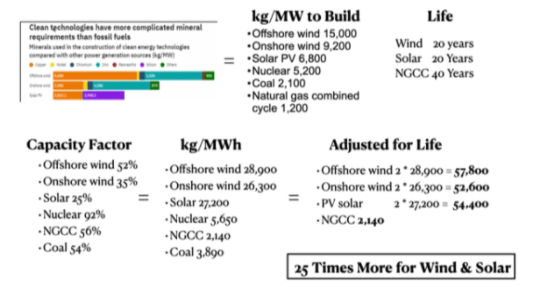
Energy reliability is everything
By Donn Dears
A recent Wall Street Journal article, The Power Struggle, raised the importance of grid reliability, but claimed that electric grid failures were caused by climate change.
The claim that climate risk is undermining grid reliability is an illusion. The WSJ article correctly diagnosed the danger of blackouts, but incorrectly determined that the cause was climate change.
It is their proposed cure, i.e. more wind, solar and batteries for storage, that is causing the problem.
As usual, some of their assumptions are wrong.
For example, the WSJ article said:
1.) “Wind and solar technologies have become increasingly cost-competitive and now rival coal, nuclear and, in some places, gas-fired plants.”
And:
2.) “Unlike electric systems in Europe, distribution and transmission lines in the U.S. were typically built overhead instead of buried underground, which makes them more vulnerable to weather.”
And:
3.) ”Wind and solar farms, whose output depends on weather and time of day, have become some of the most substantial sources of power in the U.S., second only to natural gas.”
Here are some facts:
1.) Wind and solar are not less costly than existing natural gas combined cycle (NGCC), coal-fired or nuclear power plants. They are also not less costly than new NGCC power plants. And they are, without question, far more costly when the cost of batteries, needed to backup up wind and solar, are included in the cost of generating and distributing electricity.
2.) Transmission lines in Europe are above ground except for a few DC transmission lines, mostly used to span waterways, just as in the US. The US has many more suburbs which resulted in distribution lines being built above ground, but distribution lines in new developments, since the 1960s, have largely been built underground.
I place the time as the 1960s because I was a manager at the plant making distribution transformers when we began making pad-mounted transformers used for underground distribution. Subsequently, in the 1990s, while living in Reston, I happened across one of the compact pad-mounted transformers we had shipped to the Reston developer, Bob Simon, in 1963.
3.) Wind and solar are not a substantial “source of power” generated by all power plants serving the grid. Together, wind and solar only provided 10.6% of the electricity in 2020.
Rather than solving problems, wind and solar are creating problems and increasing costs.
Reliability
Wind and solar are increasing the likelihood of blackouts. This is explained in the book, The Looming Energy Crisis, Are Blackouts Inevitable?
These two recent article provide some details about why using wind and solar are hurting reliability.
- Texas Remains in Perilhttps://bit.ly/3AD06Vd
- TX and CA Canneries in the Coal Minehttps://bit.ly/3dd2NSZ
Cost
Wind and solar are increasing costs for two reasons:
- Their actual costs are larger than reported in the media.
- Wind and solar must have backup, usually using batteries, and the cost of storage is not included in levelized cost of electricity (LCOE). The cost of storage is usually paid for by the utility.
These two recent articles provide some details concerning costs.
- Objective analysis of Wind Energyhttps://bit.ly/3yI6MiS
- Lazard Wind and Solar Costs, Part 1https://bit.ly/3EWo1jm

This chart shows that wind and solar require 25 times more critical materials than NGCC power plants, resulting in the US being dependent on other countries.
Summary
The WSJ article cites several situations where the grid is stressed, and includes this admonition by a professor at Wayne State University:
“Everything is tied to having electricity, and yet we’re not focusing on the reliability of the grid. That’s absurd, and that’s frightening.”
He, and all Americans, should be terrified by the addition of wind and solar to the grid and how baseload, dispatchable power plants, i.e., natural gas, coal-fired and nuclear, are being removed from the grid.
Author
Donn is an engineer and retired senior executive of the General Electric Company who spent his career in the power sector. He led organizations that provided engineering services for GE’s large electrical apparatus and spearheaded the establishment of GE subsidiary companies around the world. Donn actively participated in providing engineering services to a wide range of industries, including electric utilities, steel, mining, and transportation.
From cfact.org